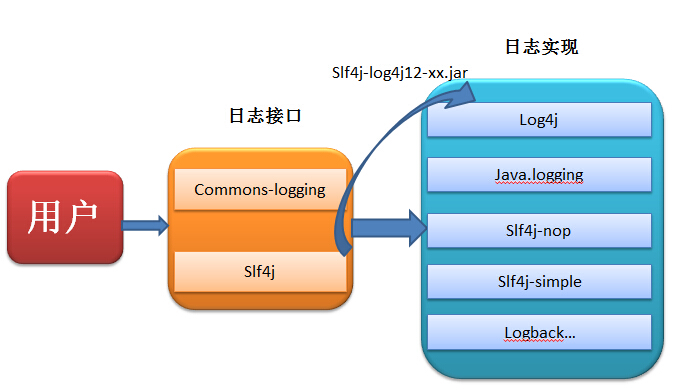您好,登錄后才能下訂單哦!
您好,登錄后才能下訂單哦!
本篇內容介紹了“web日志源碼分析”的有關知識,在實際案例的操作過程中,不少人都會遇到這樣的困境,接下來就讓小編帶領大家學習一下如何處理這些情況吧!希望大家仔細閱讀,能夠學有所成!

通過本圖可以理清楚日志之間的關系,
commons-logging和slf4j都是日志的接口,供用戶使用,而沒有提供實現!
log4j,logback等等才是日志的真正實現。
目前的日志框架有jdk自帶的logging,log4j1、log4j2、logback
目前用于實現日志統一的框架apache的commons-logging、slf4j
為了理清它們的關系,與繁雜的各種集成jar包,如下:
log4j、log4j-api、log4j-core
log4j-1.2-api、log4j-jcl、log4j-slf4j-impl、log4j-jul
logback-core、logback-classic、logback-access
commons-logging
slf4j-api、slf4j-log4j12、slf4j-simple、jcl-over-slf4j、slf4j-jdk14、log4j-over-slf4j、slf4j-jcl
1.jdk 自帶的log,
java.util.logging.Logger l = java.util.logging.Logger.getLogger(Deme.class.getName());
查看源碼,主要是構建LoggerManage的時候讀取配置文件
public static LogManager getLogManager() {
if (manager != null) {
manager.ensureLogManagerInitialized();
}
return manager;
}
final void ensureLogManagerInitialized() {
final LogManager owner = this;
//省略
// Read configuration.
owner.readPrimordialConfiguration();
}
private void readPrimordialConfiguration() {
//省略
readConfiguration();
}
public void readConfiguration() throws IOException, SecurityException {
//省略
//默認是jre目錄下的lib/logging.properties文件,也可以自定義修改系統屬性"java.util.logging.config.file",源碼如下:
String fname = System.getProperty("java.util.logging.config.file");
if (fname == null) {
fname = System.getProperty("java.home");
if (fname == null) {
throw new Error("Can't find java.home ??");
}
File f = new File(fname, "lib");
f = new File(f, "logging.properties");
fname = f.getCanonicalPath();
}
try (final InputStream in = new FileInputStream(fname)) {
final BufferedInputStream bin = new BufferedInputStream(in);
readConfiguration(bin);
}
}2.1 log4j1 真正實現日志讀寫
//jar包引入
<dependency>
<groupId>log4j</groupId>
<artifactId>log4j</artifactId>
<version>1.2.17</version>
</dependency>
//初始化,查看源碼,
org.apache.log4j.Logger logger1 = org.apache.log4j.Logger.getLogger("class or className");public class Logger extends Category {
//可以看到 Logger繼承了Category 類,這個類打印日志信息的時候有用。
Logger getLogger(String name) {
return LogManager.getLogger(name);
}
}
public class LogManager {
//主要是 LogManager 的getLogger方法
Logger getLogger(final String name) {
// Delegate the actual manufacturing of the logger to the logger repository.
return getLoggerRepository().getLogger(name);
}
//LogManager 類有個靜態方法
static {
//初始化一個logger倉庫Hierarchy,然后綁定到LoggerManager上,主要是通過getLoggerRepository()方法獲取。
// By default we use a DefaultRepositorySelector which always returns 'h'.
Hierarchy h = new Hierarchy(new RootLogger((Level) Level.DEBUG));
repositorySelector = new DefaultRepositorySelector(h);
/** Search for the properties file log4j.properties in the CLASSPATH. */
String override =OptionConverter.getSystemProperty(DEFAULT_INIT_OVERRIDE_KEY,
null);
// if there is no default init override, then get the resource
// specified by the user or the default config file.
if(override == null || "false".equalsIgnoreCase(override)) {
String configurationOptionStr = OptionConverter.getSystemProperty(DEFAULT_CONFIGURATION_KEY ,null);
//省略代碼
// 這里配置文件有個加載順序
// log4j.defaultInitOverride > log4j.configuration > log4j.xml > log4j.properties
}
//通過查看Hierarchy這個類
}
public class Hierarchy implements LoggerRepository, RendererSupport, ThrowableRendererSupport {
private LoggerFactory defaultFactory; //創建Logger工廠
Hashtable ht; //存放工廠創建的Logger
Logger root; //用于承載解析配置文件的結果,設置級別,同時存放appender
//省略
//構造方法
public Hierarchy(Logger root) {
ht = new Hashtable();
listeners = new Vector(1);
this.root = root;
// Enable all level levels by default.
setThreshold(Level.ALL);
this.root.setHierarchy(this);
rendererMap = new RendererMap();
defaultFactory = new DefaultCategoryFactory();
}
}2.2 log4j2 日志源碼解析
//添加jar包, <dependency> <groupId>org.apache.logging.log4j</groupId> <artifactId>log4j-api</artifactId> <version>2.2</version> </dependency> <dependency> <groupId>org.apache.logging.log4j</groupId> <artifactId>log4j-core</artifactId> <version>2.2</version> </dependency> og4j2分成2個部分: log4j-api: 作為日志接口層,用于統一底層日志系統 log4j-core : 作為上述日志接口的實現,是一個實際的日志框架 web.xml 添加如下信息 <listener> <listener-class>org.apache.logging.log4j.web.Log4jServletFilter</listener-class> </listener> <filter> <filter-name>log4jServletFilter</filter-name> <filter-class>org.apache.logging.log4j.web.Log4jServletFilter</filter-class> </filter> <filter-mapping> <filter-name>log4jServletFilter</filter-name> <url-pattern>/*</url-pattern> <dispatcher>REQUEST</dispatcher> <dispatcher>FORWARD</dispatcher> <dispatcher>INCLUDE</dispatcher> <dispatcher>ERROR</dispatcher> </filter-mapping> //創建對象 Logger logger = LoggerFactory.getLogger(DemeMapping.class);
//LoggerFactory的getlogger方法
public final class LoggerFactory {
public static Logger getLogger(Class<?> clazz) {
Logger logger = getLogger(clazz.getName());
if (DETECT_LOGGER_NAME_MISMATCH) {
Class<?> autoComputedCallingClass = Util.getCallingClass();
if (nonMatchingClasses(clazz, autoComputedCallingClass)) {
Util.report(String.format("Detected logger name mismatch. Given name: \"%s\"; computed name: \"%s\".", logger.getName(), autoComputedCallingClass.getName()));
Util.report("See http://www.slf4j.org/codes.html#loggerNameMismatch for an explanation");
}
}
return logger;
}
//獲取logger對象
public static Logger getLogger(String name) {
//最終獲取的是Log4jLoggerFactory對象實現了ILoggerFactory接口
ILoggerFactory iLoggerFactory = getILoggerFactory();
//調用的其實是Log4jLoggerFactory這個類
return iLoggerFactory.getLogger(name);
}
public static ILoggerFactory getILoggerFactory() {
//初始化,并且改變INITIALIZATION_STATE = 3
performInitialization();
case 3:
return StaticLoggerBinder.getSingleton().getLoggerFactory();
}
//主要看里面bind方法
private static final void bind() {
String msg;
try {
//這里通過類加載方式找到StaticLoggerBinder對象,
//代碼里面定義路徑:"org/slf4j/impl/StaticLoggerBinder.class">3 logback 日志解析
需要的jar包
logback-core
logback-classic
slf4j-api
//添加maven依賴 <dependency> <groupId>ch.qos.logback</groupId> <artifactId>logback-core</artifactId> <version>1.1.3</version> </dependency> <dependency> <groupId>ch.qos.logback</groupId> <artifactId>logback-classic</artifactId> <version>1.1.3</version> </dependency> <dependency> <groupId>org.slf4j</groupId> <artifactId>slf4j-api</artifactId> <version>1.7.12</version> </dependency> //或者 <dependency> <groupId>framework.pisces</groupId> <artifactId>pisces-log</artifactId> <version>1.2.3-beta</version> <exclusions> <exclusion> <groupId>com.fasterxml.jackson.module</groupId> <artifactId>jackson-module-jaxb-annotations</artifactId> </exclusion> <exclusion> <!-- Also, XML serialization/deserialization... --> <groupId>com.fasterxml.jackson.dataformat</groupId> <artifactId>jackson-dataformat-xml</artifactId> </exclusion> <exclusion> <!-- also need JAXB annotation support --> <groupId>com.fasterxml.jackson.module</groupId> <artifactId>jackson-module-jaxb-annotations</artifactId> </exclusion> <exclusion> <groupId>com.fasterxml.jackson.jaxrs</groupId> <artifactId>jackson-jaxrs-xml-provider</artifactId> </exclusion> <exclusion> <artifactId>slf4j-log4j12</artifactId> <groupId>org.slf4j</groupId> </exclusion> <exclusion> <groupId>log4j</groupId> <artifactId>log4j</artifactId> </exclusion> </exclusions> </dependency>
//申明變量
org.slf4j.Logger logger2 = LoggerFactory.getLogger("");
//用到的也是 LoggerFactory來創建
public final class LoggerFactory {
public static Logger getLogger(String name) {
ILoggerFactory iLoggerFactory = getILoggerFactory();
return iLoggerFactory.getLogger(name);
}
}
//這里的調用和slf4j是一樣getILoggerFactory()-> performInitialization(); -> bind(); -> findPossibleStaticLoggerBinderPathSet(); -> 返回LoggerContext對象
//唯一不同是構造StaticLoggerBinder的地址是 "org/slf4j/impl/StaticLoggerBinder.class" ,在調用StaticLoggerBinder.getSingleton(); 用的是 logback-classic-0.9.21.jar包下的StaticLoggerBinder
public class StaticLoggerBinder implements LoggerFactoryBinder {
//可以看到這里初始化并賦值 LoggerContext 對象
private LoggerContext defaultLoggerContext = new LoggerContext();
static {
SINGLETON.init();
}
void init() {
try {
//這里就是初始化并存儲值defaultLoggerContext,看看autoConfig()方法,里面主要是findURLOfDefaultConfigurationFile(true); 方法在讀取配置文件,
new ContextInitializer(defaultLoggerContext).autoConfig();
}
private static StaticLoggerBinder SINGLETON = new StaticLoggerBinder();
public static StaticLoggerBinder getSingleton() {
return SINGLETON;
}
private StaticLoggerBinder() {
defaultLoggerContext.setName(CoreConstants.DEFAULT_CONTEXT_NAME);
}
}“web日志源碼分析”的內容就介紹到這里了,感謝大家的閱讀。如果想了解更多行業相關的知識可以關注億速云網站,小編將為大家輸出更多高質量的實用文章!
免責聲明:本站發布的內容(圖片、視頻和文字)以原創、轉載和分享為主,文章觀點不代表本網站立場,如果涉及侵權請聯系站長郵箱:is@yisu.com進行舉報,并提供相關證據,一經查實,將立刻刪除涉嫌侵權內容。